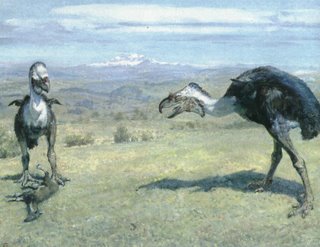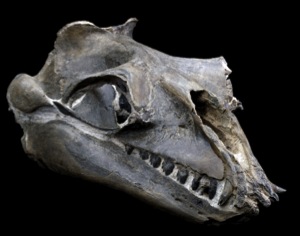 Dinosaurs Life Size was written by Darren Naish, author of the Tetrapod Zoology blog. As the title implies, it's meant to give an idea as to just how large those critters were. Obviously, most of them are too big to fit into a children's book, but....
Dinosaurs Life Size was written by Darren Naish, author of the Tetrapod Zoology blog. As the title implies, it's meant to give an idea as to just how large those critters were. Obviously, most of them are too big to fit into a children's book, but....Twenty dinosaurs are included in the book, ranging chronologically from the Triassic Herrerasaurus to the late Cretaceous Citipati, and in size from Microraptor (which almost fits onto its page) to big sauropods like Diplodocus (up to 115 feet long) and Sauroposeidon (an estimated 40 tons). There are also several non-dinosaurs, including the plesiosaurs Plesiosaurus and Liopleurodon, the ichthyosaur Stenopterygius, the pterosaurs Pterodactylus and Quetzalcoatlus, and the early bird Archaeopteryx (which in many ways resembles its theropod ancestors more than its modern avian relatives).
The good: For each one, we get:
- A life-sized picture of the animal, of course - if it will fit on the page. If not, there's a life-sized picture of part of it, plus a picture of the complete animal with the part that's shown life-sized marked. The traditional human is included to provide scale; since this is a children's book, however, instead of the usual silhouette of a man there's a painting of a child interacting with the animal. (The kids with the aquatic reptiles have swimsuits and snorkels, of course!)
- A box showing where and when the fossils were first found.
- Another box, discussing its size, both weight height/length/wingspan.
- A couple paragraphs of text describing it.
- A "WOW!" fact or two. ("A Velociraptor specimen was discovered locked in combat with a Protoceratops. The Protoceratops had bitten onto the predator's arm, but the Velociraptor's left sickle-claw was pushed up against the herbivore's neck.")
The bad: My only complaint concerns the Pterodactylus picture: It says the critter was "roughly similar in size to a large gull," but that life-sized rendition doesn't look anywhere near as large as the gulls I see around here almost every day. Naish has mentioned in his blog, though, that "some of the 'life sized' animals are scaled wrong."
All in all, it's a very nice book, and I'd recommend it for any child who's interested in the subject.
Dinosaurs Life Size, by Darren Naish. Barron's, 2010. Children (4-8, according to Amazon). Available from Amazon and Barnes & Noble, of course. I haven't seen any other reviews, but Naish's own discussion of the book is here.
 Nonfiction Monday is hosted this week by Sherrie, at Write About Now.
Nonfiction Monday is hosted this week by Sherrie, at Write About Now.















